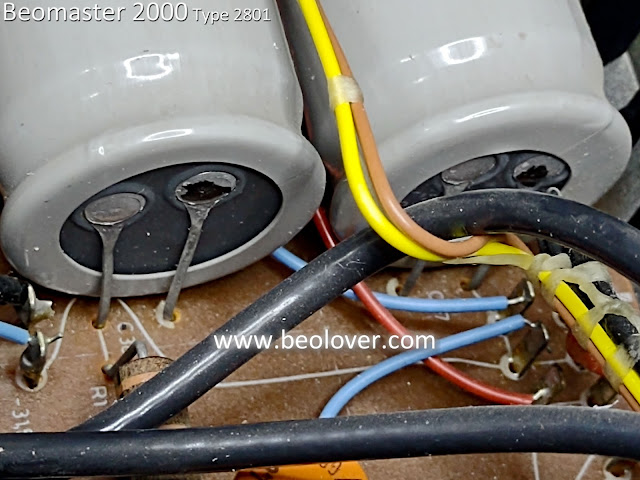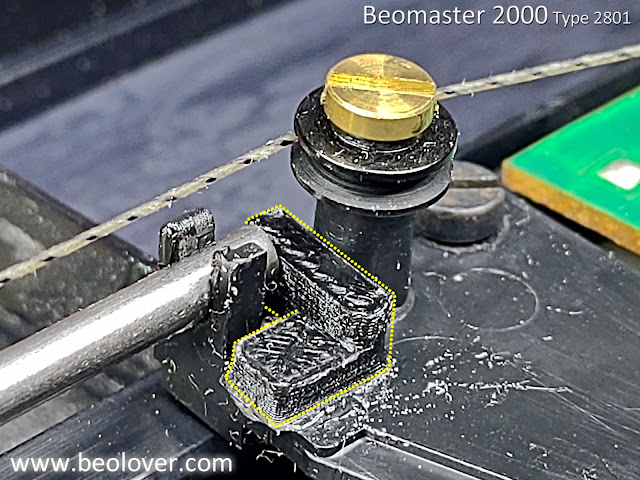I received most of the electronic components I needed to restore this Beomaster 2000 receiver.
Compared to the last few Beomaster receivers I have restored this one will have the least amount of capacitors replaced. As I mentioned in the previous blog post ...for this unit I will leave in all of the red tantalum capacitors if a spot check shows them to be good...and it did.
Here is a small sampling of three different tantalum capacitors from the Beomaster 2000.
I didn't remove and test every single tantalum but I tested enough where I was satisfied the plan to leave them in is sound (sorry for the unintended pun :-) ).
I did replace the electrolytic capacitors, the no-load current adjustment trimmers (two...one for the left channel and one for the right channel) and the 2D8 bridge rectifier.
Here is a before and after photo of the 470uF 2C24 capacitor and the 2D8 bridge rectifier (located on PCB 2).
Before:
After:
Before:
After:
Note: The thermal compound on the transistors mounted on the rear heat sink of the Beomaster 2000 cabinet was still soft so I left those alone. If there ends up being a problem with the transistors and I have to replace any, I will rework all of the output transistors.
For now...they are left as they are.
Before:
After:
That sums up the PCB component replacement tasks.
PCB 3 (Pre-set Tuning board) required desoldering of the five pre-set dials.
The issue with this board was that the black, plastic adjustment knob for each preset was slipping.
I cleaned all of the preset components with some fader lube, glued on the plastic knobs and then reinstalled the five presets to PCB 3.
I set the voltage selection switch to 130 VAC as here in the USA the line voltage is closer to 130 V than it is to 110 V (the other voltage switch selection option available to me).
On these initial power up tests I use my variac and dim bulb tester to protect any short circuits to ground in the Beomaster power supply path.
For reference here is the Beomaster 2000 Type 2801 line voltage supply wire routing for the four voltage select options. Top left is the wiring for my selection.
One set should be at 26 V and the other should be 46 V.
Those are good values for the power coming in.
Checking the resulting ±30 VDC rail voltages I measure -
Now to check the +26 VDC adjustment called for in the Beomaster 2000 service manual.
I monitored the +26V test point and adjusted the trimmer to get as close to 26V as I could.
After that I adjusted the output amplifier no-load current for both channels per the service manual.
The adjustment calls for no speakers connected, the volume level at zero, the amplifier warmed up and a measurement of 10mVDC across emitter resistors (7R119 : LCh, 7R219 : RCh).
Here are those measurements using the new Bourns multi-turn trimmers I installed to adjust the voltages.
Left Channel
Right Channel
Now to hook up speakers and see if I have music playing from this receiver.
This picture shows my little iPod Nano providing the music source to the Beomaster 2000 Tape 2 input.
You can also see in the photo that the lamp for the tuner dial is illuminated.
Listening to music from the restored amplifier is a nice milestone to reach in the project.
Normally I would move into some performance testing but there are a few problems to address with this Beomaster first.
There are no lamps lit up on the PCB 4 Indicator circuit. It has four 12V, 30mA lamps and they appear to be burned out.
I should have checked that earlier but now I will have to wait for those parts to arrive.
When examining the tuner dial cord I discovered another problem. The cord has a spot that is badly frayed. I don't want to put in all of this work only to have the cord break later. I ordered a replacement for that and will also have to wait for that to be delivered.
I also had to repair two of the tuning cord pulley posts because there were defects in the plastic parts.
On the left side of the dial window the plastic mounting tab for the pulley was broken when I initially checked over the Beomaster 2000 inside.
I was able to glue that broken piece back together but the break across the plastic part will see a lot of stress so I don't think it will hold up over time on its own.
For that reason I fashioned a u-channel reinforcement part that I could epoxy into place across the break.
There appeared to be a missing pieces (a plastic tab) that keeps the metal rod for the dial assembly from pulling out of place.
I fashioned a second 3D part to keep metal rod in place. It too was installed using some epoxy.
That was not the end of the problems for the right side dial cord pulley though.
I could easily see that the pulley assembly was loose and would not remain in place when the tension of the dial cord was pressing on it.
It turns out there were some cracks in the plastic mounting post for that pulley assembly.
For that repair I made a ring for the post so the cracks in the post couldn't expand.
That work out really well. Satisfied that repair would work I epoxied the ring in place.
This Beomaster should be ready for further testing once the replacement lamps and new dial cord arrive.






































No comments:
Post a Comment
Comments and suggestions are welcome!